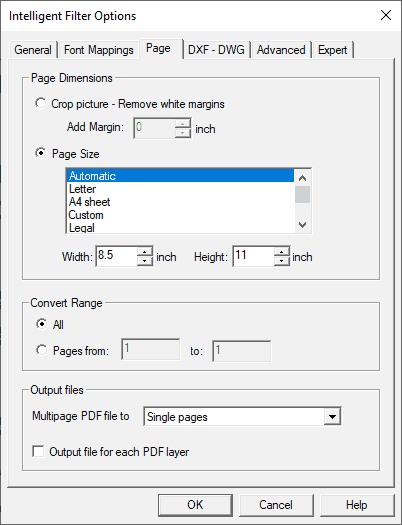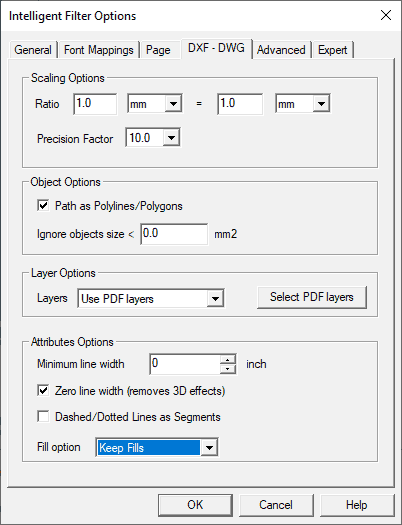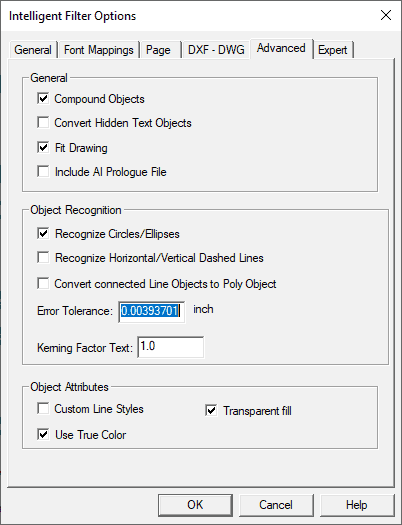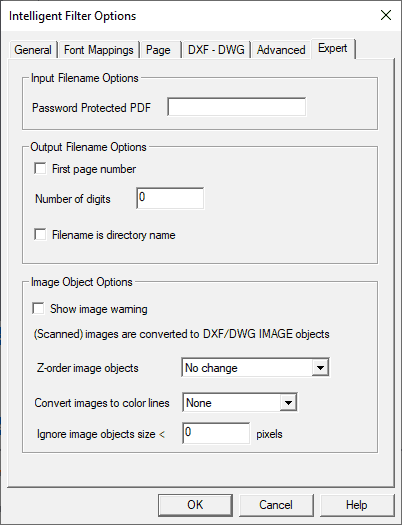PDF Conversion Options
Below is a summary of all vector PDF conversion options available in pdf2cad, pdf2picture and PDF FLY. These options and more are also available to developers via the PDF Conversion SDK/API or command line tools.
General Settings Tab
- Characters as Strings. Combines characters into words, and words into text strings, based on context.
- Convert Characters to Curves. Creates a visual graphic match for text defined with unknown or unavailable fonts.
- Rotate: Rotates drawing any degree in either direction.
- Scale Text: Enlarges or reduces the size of the text in the converted file.
- Emulate PDF cropping: Cropping removes unnecessary outer areas of a drawing. PDF supports cropping but some vector formats (WMF, CGM, DXF, and HPGL) don’t. Without cropping, these formats would transfer unwanted elements during conversion. Activate ‘Emulate PDF cropping’ to ensue clean borders. Using this feature, the resulting file will match the original.PDF.
- Show Font Warning: If the fonts in a PDF file are not installed on your computer, the text will not look right. Font mapping ensures the closest match possible. It also compensates for different font naming conventions across systems.
- Ignore paths, text images: Turn certain elements on or off during conversion.
- CAD Format: Choose your output format. DWG for AutoCAD, DXF for most engineering and technical programs, and HPGL for plotter-specific applications.
Font Mappings Tab
Text converts fine when PDF files use standard fonts. If text converts but doesn’t display right, you have a font mapping issue. Fonts are a tricky subject. Installed fonts differ from system to system. Sometimes, the same font may even go by different names. For a perfect conversion, the same font needs to be on the source and target system. License agreements protect font vendors from the illegal use of their typefaces. Embed only system fonts and permitted fonts. For more detail on font issues, read PDF Font Mapping When Converting Files and PDF Fonts: Embedding and Substitution from Adobe.
Document fonts display based on comparing the font name in the PDF file with the font name on your system. If the fonts on your PC match the PDF, the file will look perfect. Often, the font names don’t match and the text looks ‘off’. The first thing to check is whether you have a font name mismatch. Arial Bold, for example, may be “EHJPKB+Arial-Bold” in the original file. The same font is “Arial” on your PC. When you match the two, it’s known as “Font Mapping”. In this example, map “EHJPKB_Arial-Bold” to “Arial” with font style “Bold”. If you can’t make a successful match, we substitute the closest font. This is “Font Substitution” and is automatic.
Page Settings Tab
The Page Settings control options apply to all files. All of the other options vary depending on whether you choose a vector or bitmap output format.
Crop Picture: Remove Margin: By default, the margins of the PDF file are used. This setting can adjust or remove white space.
Page Size: pdf2cad will automatically figure out the page size. If you want to force a standard or custom page size, select it or enter dimensions.
Convert Range: pdf2cad, by default, will convert all pages of a file. You can set a page range if you only want selected pages.
Page Mapping: By default, a multi-page PDF file converts into a vector page for each PDF page. Other choices included include merging all pages into one file and applying horizontal or vertical alignment.
DWG and DXF Format Specific Options
The PDF Conversion Options for DWG and DXF options apply to specific CAD drawing features.
Fill option: Sometimes, white fills in a PDF file show up as black fills in a DXF file. If this is a problem, use this option to ignore white fills.
Advanced DXF and DWG Options
Recognize Circles/Ellipses: Our object recognition engine identifies closed polygons and circular paths. Convert them into circular and elliptical shapes.
Use True Color: Uses RGB true color values in the CAD file. By default, files use an indexed 256-color table.
Expert CAD Options
Password Protected PDF. If the PDF file you are converting has a password, enter it here.
Ignore Image Objects Size Less Than. This option strips small image objects during conversion.



